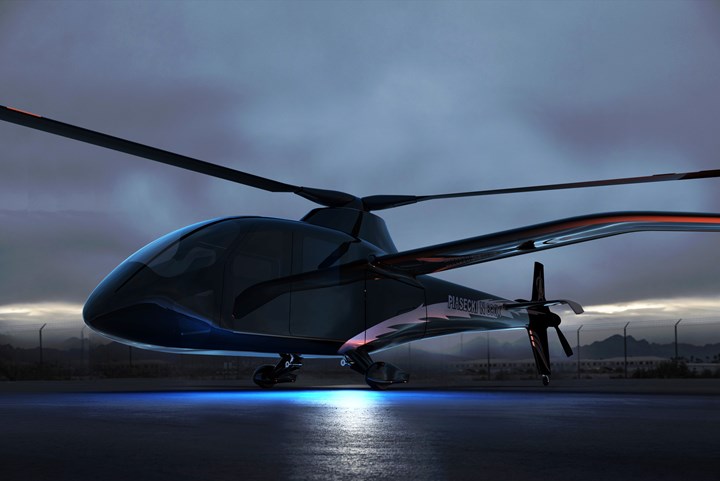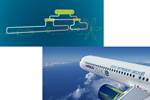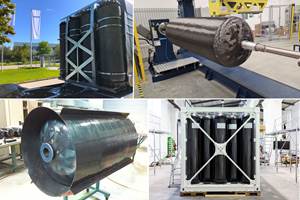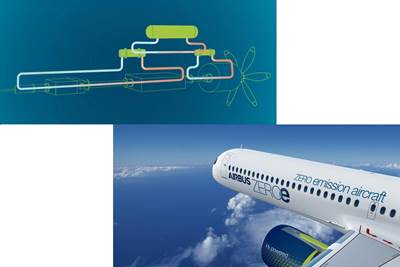HyPoint, Piasecki Aircraft collaborate to develop, certify eVTOL next-generation hydrogen fuel cells
Initial $6.5 million agreement to culminate in the development of five 650-kilowatt hydrogen fuel cell systems for use in Piasecki’s eVTOL PA-890 compound helicopter.

Rendering of the Piasecki PA-890 eVTOL compound helicopter, powered by the HyPoint turbo air-cooled hydrogen fuel cell system. Photo Credit: Piasecki Aircraft, HyPoint.
HyPoint (Menlo Park, Calif., U.S.), a company developing zero carbon-emission turbo air-cooled hydrogen fuel cell systems for aviation and urban air mobility (UAM), has entered into a multi-phase collaborative development agreement with advanced rotorcraft and unmanned aircraft systems (UAS) platforms and technologies company Piasecki Aircraft Corp. (PiAC, Essington, Penn., U.S.) for the development and certification of a hydrogen fuel cell system for electric vertical take-off and landing (eVTOL) vehicle applications. The initial $6.5 million agreement will culminate in the development of five 650-kilowatt hydrogen fuel cell systems for use in Piasecki’s eVTOL PA-890 compound helicopter, which the company says is expected to be the first manned hydrogen-powered helicopter.
The partnership’s objective is to deliver a customizable, FAA-certified, zero carbon-emission hydrogen fuel cell system to the global eVTOL marketplace. The system will reportedly offer eVTOL makers four times the energy density of existing lithium-ion batteries, twice the specific power of existing hydrogen fuel cell systems and up to a 50% reduction in direct operating costs relative to turbine-powered rotorcraft. Piasecki will gain exclusive license to the technology created as part of the partnership, and HyPoint will maintain ownership of its underlying hydrogen fuel cell technology. Piasecki and HyPoint intend to make the new system available to eVTOL makers by customizing it for use in their vehicles. Alternatively, eVTOL makers may choose to partner with HyPoint and Piasecki to develop a new system based on their specific needs.
“Our objective is to develop full-scale systems within two years to support on-aircraft certification testing in 2024 and fulfill existing customer orders for up to 325 units starting in 2025.”
HyPoint’s approach uses compressed air for both cooling and oxygen supply to deliver a hydrogen fuel cell system that is said to radically outperform existing battery and hydrogen fuel cell alternatives. Testing has shown that HyPoint's fuel cell system will be able to achieve up to 2,000 watts per kilogram of specific power, which is more than triple the power-to-weight ratio of traditional (liquid-cooled) hydrogen fuel cells systems. It will also boast up to 1,500 watt-hours per kilogram of energy density, enabling longer-distance journeys. In December 2020, HyPoint was named a winner of NASA's iTech Initiative, in which breakthrough technologies were ranked based on criteria that included technical viability, benefits to humanity and commercialization potential. HyPoint’s aviation applications — including eVTOL, UAS, personal air vehicles and electric aircraft — were considered to be especially innovative.
“The much-anticipated arrival of eVTOLs and similar aircraft has been severely hindered by the technical limitations of existing power systems,” says Dr. Alex Ivanenko, founder and CEO of HyPoint. “This new strategic partnership will dramatically accelerate delivery timelines by equipping eVTOL manufacturers with next-generation hydrogen fuel cell systems that meet their unique needs. Together, HyPoint and Piasecki will work to grow the emerging eVTOL market by delivering a certified multiplatform solution for eVTOL makers. In addition, we share a common vision for making safe, cost-effective zero carbon-emission flight a reality for conscientious businesses and consumers around the world.”
According to the partners, global eVTOL market size is forecasted to grow from an estimated $74 million in 2025 to $860 million by 2030, according to new market research. In the first few months of 2021 alone, $5 billion of investments were announced in the sector to Archer Aviation, Eve, Joby Aviation, Lilium and Vertical Aerospace. In January 2020, the Federal Aviation Administration (FAA) announced that it was engaged with manufacturers of more than 15 eVTOL aircraft. EHang, Volocopter, Joby Aviation and Lilium are among those that have signaled an intent to launch commercial passenger operations within the next three to five years. Other players include major aircraft companies such as Airbus and Boeing. The global hydrogen aircraft market is anticipated to grow from an estimated $27 billion in 2030 to $174 billion by 2040, according to Allied Market Research.
Piasecki is currently working with the FAA to outline certification criteria, as well as with the United States Air Force, by way of its AFWERX STTR/SBIR program, which is co-investing in the development of advanced hydrogen-powered aeronautical technology.
“We are laser-focused on the development and qualification of a 650-kilowatt system for our PA-890 eVTOL compound helicopter. Success will pave the way for collaboration with other eVTOL OEMs with different platform sizes to ensure broad application of this technology,” says John Piasecki, president and CEO of Piasecki. “Initial lab testing funded by Piasecki last winter demonstrated the technical viability of HyPoint’s hydrogen fuel cell system. While we are benchmarking HyPoint’s technology against alternatives and continue to rigorously test and validate findings, we are very optimistic. Our objective is to develop full-scale systems within two years to support on-aircraft certification testing in 2024 and fulfill existing customer orders for up to 325 units starting in 2025.”
Related Content
Midnight production aircraft completes full transition flight
This is Archer’s second full-scale eVTOL aircraft to achieve this milestone, critical to being able to carry commercially viable passenger payloads.
Read MoreAerospace prepregs with braided reinforcement demonstrate improved production rates, cost
A recent time study compares the layup of a wing spar using prepreg with A&P’s TX-45 continuous braided reinforcement versus traditional twill woven prepreg.
Read MoreComposites end markets: New space (2025)
Composite materials — with their unmatched strength-to-weight ratio, durability in extreme environments and design versatility — are at the heart of innovations in satellites, propulsion systems and lunar exploration vehicles, propelling the space economy toward a $1.8 trillion future.
Read MoreComposites end markets: Pressure vessels (2024)
The market for pressure vessels used to store zero-emission fuels is rapidly growing, with ongoing developments and commercialization of Type 3, 4 and 5 tanks.
Read MoreRead Next
Airbus ASCEND program to explore liquid hydrogen and superconductivity for zero-emission aircraft
Cryogenic hydrogen as cold source for lightweight, low-electrical loss powertrain, with composite materials as possible insulation.
Read MoreUltrasonic welding for in-space manufacturing of CFRTP
Agile Ultrasonics and NASA trial robotic-compatible carbon fiber-reinforced thermoplastic ultrasonic welding technology for space structures.
Read MoreNext-gen fan blades: Hybrid twin RTM, printed sensors, laser shock disassembly
MORPHO project demonstrates blade with 20% faster RTM cure cycle, uses AI-based monitoring for improved maintenance/life cycle management and proves laser shock disassembly for recycling.
Read More


























